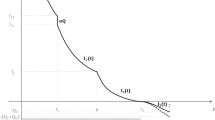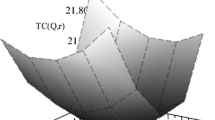Abstract
We consider a stochastic EOQ-type model, with demand operating in a two-state random environment. This environment alternates between exponentially distributed periods of high demand and generally distributed periods of low demand. The inventory level starts at some level q, and decreases according to different compound Poisson processes during the periods of high demand and of low demand. Refilling of the inventory level to level q is required when level 0 is hit or when an expiration date is reached, whichever comes first. If such an event occurs during a high demand period, an order is instantaneously placed; otherwise, ordering is postponed until the beginning of the next high demand period. We determine various performance measures of interest, like the distribution of the inventory level at time t and of the inventory demand up to time t, the distribution of the time until refilling is required, the expected time between two refillings, the expected amount of discarded material and the expected total amount of material held in between two refillings, and the expected values of various kinds of shortages. For a given cost/revenue structure, we can thus determine the long-run average profit.


Similar content being viewed by others
References
Abramowitz, M., & Stegun, I. A. (1968). Handbook of mathematical functions. New York: Dover.
Baron, O., Berman, O., & Perry, D. (2010). Continuous review inventory models for perishable items ordered in batches. Mathematical Methods of Operations Research, 72, 217–247.
Berk, E., & Gürler, U. (2008). Analysis of the \((Q, r)\) inventory model for perishables with positive lead times and lost sales. Operations Research, 56(5), 1238–1246.
Boxma, O. J., Perry, D., & Zacks, S. (2015). A fluid EOQ model of perishable items with intermittent high and low demand rates. Mathematics of Operations Research, 40, 390–402.
Deniz, B., Karaesmen, I., & Scheller-Wolf, A. (2010). Managing perishables with substitution: Issuance and replenishment heuristics. Manufacturing & Service Operations Management, 12, 319–329.
Giri, B. C., & Chaudhuri, K. S. (1998). Deterministic models of perishable inventory with stock-dependent demand rate and nonlinear holding cost. European Journal of Operational Research, 105, 467–474.
Graves, S. (1982). The application of queueing theory to continuous perishable inventory systems. Management Science, 28, 400–406.
Kao, E. P. C. (1997). An introduction to stochastic processes. New York: Duxbury Press.
Karaesmen, I., Scheller-Wolf, A., & Deniz, B. (2010). Managing perishable and aging inventories: Review and future research directions. In Handbook of production planning, Kempf, K., Keskinocak, P., Uzsoy, P. (eds.) Kluwer International Series in Operations Research and Management Science, Advancing the State-of-the-Art Subseries.
Lian, Z., & Liu, L. (2001). Continuous review perishable inventory systems: Models and heuristics. IIE Transactions, 33, 809–822.
Lian, Z., Liu, L., & Neuts, M. (2005). A discrete-time model for common lifetime inventory systems. Mathematics of Operations Research, 30, 718–732.
Liu, L., & Lian, Z. (1999). (\(s;S\)) continuous review models for products with fixed lifetimes. Operations Research, 47, 150–158.
Nahmias, S. (1982). Perishable inventory theory: A review. Operations Research, 30, 680–708.
Nahmias, S. (2011). Perishable inventory systems. New York: Springer.
Pal, M. (1989). The (\(S-1, S\)) inventory model for deteriorating items with exponential lead time. Calcutta Statistical Association Bulletin, 38, 83–91.
Perry, D., Stadje, W., & Zacks, S. (2005). Sporadic and continuous clearing policies for a production/inventory system under \(M/G/\) demand. Mathematics of Operations Research, 30(2), 354–368.
Prabhu, N. U. (1965). Queues and inventories. New York: Wiley.
Raafat, F. (1991). Survey of literature on continuously deteriorating inventory models. Journal of the Operational Research Society, 42, 27–37.
Shi, J., Katehakis, M. N., & Melamed, B. (2013). Martingale methods for pricing inventory penalties under continuous replenishment and compound renewal demands. Annals of Operations Research, 208, 593–612.
Shi, J., Katehakis, M. N., Melamed, B., & Xia, Y. (2014). Production-inventory systems with lost sales and compound Poisson demands. Operations Research, 62, 1048–1063.
Weiss, H. (1980). Optimal ordering policies for continuous review perishable inventory models. Operations Research, 28, 365–374.
Wilson, R. H. (1934). A scientific routine for stock control. Harvard Business Review, 13, 116–128.
Zipkin, P. H. (2000). Foundations of inventory management. New York: McGraw-Hill.
Acknowledgments
The research of David Perry and Wolfgang Stadje was supported in part by grant No. I-1184-31.4/2012 from the German-Israel Science Foundation.
Author information
Authors and Affiliations
Corresponding author
Rights and permissions
About this article
Cite this article
Boxma, O., Perry, D., Stadje, W. et al. A compound Poisson EOQ model for perishable items with intermittent high and low demand periods. Ann Oper Res 317, 439–459 (2022). https://doi.org/10.1007/s10479-015-2031-1
Published:
Issue Date:
DOI: https://doi.org/10.1007/s10479-015-2031-1




